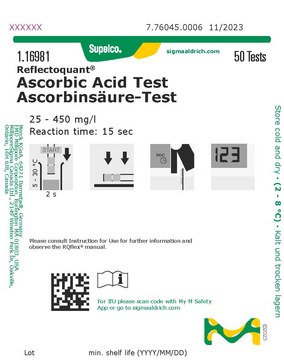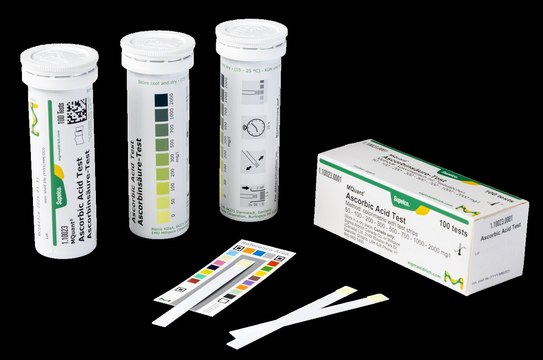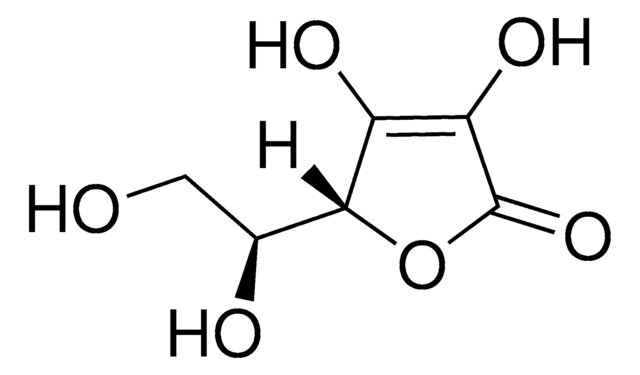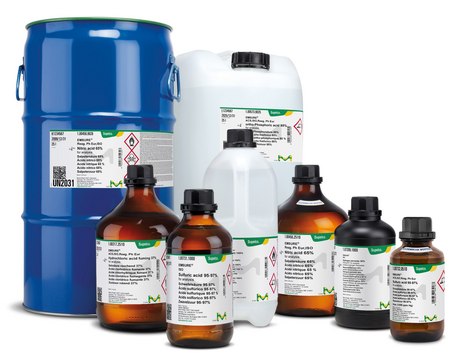MAK074
Ascorbic Acid Assay Kit
sufficient for 100 colorimetric or fluorometric tests
Synonym(s):
Vitamin C Assay Kit
Sign Into View Organizational & Contract Pricing
All Photos(2)
About This Item
UNSPSC Code:
12161503
NACRES:
NA.84
Recommended Products
usage
sufficient for 100 colorimetric or fluorometric tests
detection method
colorimetric
fluorometric
storage temp.
−20°C
General description
The new Ascorbic Acid Assay Kit, MAK505, is now available! Ascorbic Acid, also known as Vitamin C, is a six-carbon lactone produced by plants and some animal species but not by humans and other primates. Ascorbic acid functions as an enzymatic cofactor for multiple enzymes, serving as an electron donor for monooxygenases and dioxygenases. Ascorbic acid also functions as a powerful antioxidant, particularly in regards to reactive oxygen species.
Suitability
Suitable for use with biological fluids, food samples, and growth media. Proteins present in the sample can interfere with this assay. Protein containing samples are best analyzed using the Ascorbic Acid Assay II (MAK075). Alternatively, samples can be deproteinized using a 10 kDa Molecular Weight Cut-Off Spin Filter.
Principle
In this assay, Ascorbic Acid concentration is determined by a coupled enzyme reaction, which results in a colorimetric (570 nm)/fluorometric (λex = 535/ λem = 587 nm) product, proportional to the ascorbic acid present.
replaced by
Product No.
Description
Pricing
Signal Word
Danger
Hazard Statements
Precautionary Statements
Hazard Classifications
Eye Irrit. 2 - Resp. Sens. 1 - Skin Sens. 1
Storage Class Code
10 - Combustible liquids
Flash Point(F)
188.6 °F - closed cup
Flash Point(C)
87 °C - closed cup
Regulatory Information
动植物源性产品
Choose from one of the most recent versions:
Certificates of Analysis (COA)
Lot/Batch Number
Don't see the Right Version?
If you require a particular version, you can look up a specific certificate by the Lot or Batch number.
Already Own This Product?
Find documentation for the products that you have recently purchased in the Document Library.
Manas R Gartia et al.
Scientific reports, 5, 16011-16011 (2015-11-04)
Limited training, high cost, and low equipment mobility leads to inaccuracies in decision making and is concerning with serious ocular injuries such as suspected ruptured globe or post-operative infections. Here, we present a novel point-of-service (POS) quantitative ascorbic acid (AA)
Giulia Costanzo et al.
Antioxidants (Basel, Switzerland), 11(2) (2022-02-26)
In this work, we assess the potential of waste products of Phlegrean mandarin (Citrus reticulata Blanco), namely seeds and peel, to be reutilized as a source of bioactive compounds beneficial for the human diet. Starting from the evidence that the
Giulia Costanzo et al.
Antioxidants (Basel, Switzerland), 9(6) (2020-06-18)
Peel, pulp and seed extracts of three mandarin varieties, namely Phlegraean mandarin (Citrus reticulata), Kumquat (Citrus japonica), and Clementine (Citrus clementina) were compared and characterised in terms of photosynthetic pigment content, total polyphenols amount, antioxidant activity and vitamin C to
Ermenegilda Vitale et al.
Plants (Basel, Switzerland), 10(5) (2021-05-01)
This paper evaluates the combined effect of biostimulant and light quality on bioactive compound production and seedling growth of soybean (Glycine max L. Merrill) plants. Germinated seeds pre-treated with different concentrations (0.01%, 0.05%, 0.5%) of an amino acid-based biostimulant were
Stephanie P DiTroia et al.
Nature, 573(7773), 271-275 (2019-09-06)
Development is often assumed to be hardwired in the genome, but several lines of evidence indicate that it is susceptible to environmental modulation with potential long-term consequences, including in mammals1,2. The embryonic germline is of particular interest because of the
Our team of scientists has experience in all areas of research including Life Science, Material Science, Chemical Synthesis, Chromatography, Analytical and many others.
Contact Technical Service




